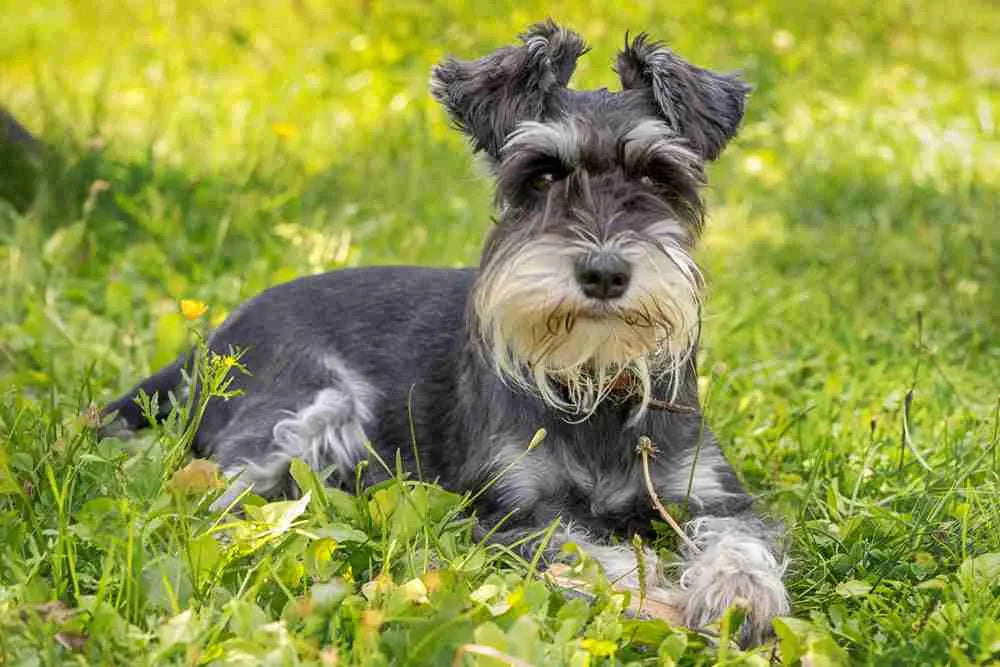Miniature Schnauzer
America’s Spirited and Adaptable Companion
1. Introduction to the Breed
The Miniature Schnauzer, holding the #18 spot in the 2024 American Kennel Club (AKC) rankings, is a spirited and adaptable breed cherished for its distinctive appearance and lively personality. Known for their wiry coats, bushy eyebrows, and alert demeanor, Miniature Schnauzers are a favorite among small-dog lovers seeking a versatile companion. Their intelligence, hypoallergenic coat, and bold character make them ideal for urban apartments, suburban homes, or active families, bringing charm and energy to any setting.
2. History of the Breed
Originating in Germany in the late 19th century, Miniature Schnauzers were bred as farm dogs to hunt vermin and guard property, derived from Standard Schnauzers crossed with smaller breeds like the Affenpinscher. Their name comes from the German schnauze, meaning “muzzle,” reflecting their distinctive bearded face. Recognized by the AKC in 1926, Miniature Schnauzers gained U.S. popularity for their compact size and versatility, excelling in dog shows, obedience trials, and as loyal family pets with a knack for alerting their owners to visitors.
3. Physical Characteristics
- Typical Size and Weight: Miniature Schnauzers are small, standing 12–14 inches tall at the shoulder and weighing 11–20 pounds for both males and females, with a sturdy, compact build.
- Coat and Color: Their double-layered, hypoallergenic coat is wiry on top with a soft undercoat, in colors like salt-and-pepper, black, or black-and-silver. Regular grooming maintains their distinctive look.
- Distinctive Features: Miniature Schnauzers have a rectangular head, bushy eyebrows, and a bearded muzzle, giving them a distinguished, expressive appearance. Their small, V-shaped ears and docked or natural tail enhance their alert posture.
4. Personality Traits
Miniature Schnauzers are intelligent, spirited, and affectionate, with a bold personality that makes them excellent watchdogs despite their small size. They form strong bonds with families, enjoying interaction with older children and familiar pets, but their terrier instincts can lead to chasing small animals. They’re vocal, often barking to alert strangers or express excitement, requiring training to manage. Their curious and playful nature suits active owners who can provide mental and physical stimulation to keep them engaged and content.
5. Care Requirements
- Exercise Needs: Miniature Schnauzers need 45–60 minutes of daily exercise, such as brisk walks, play sessions, or agility games. Mental stimulation through training or puzzle toys is essential to satisfy their sharp minds.
- Grooming Needs: Their wiry coat requires brushing 2–3 times per week and professional clipping or stripping every 6–8 weeks to maintain shape. Regular ear cleaning, nail trimming, and dental care prevent infections and dental issues common in small breeds.
- Dietary Considerations: A balanced, small-breed diet with high-quality proteins supports their energy and coat health. Portion control prevents obesity, and foods with omega fatty acids reduce skin sensitivities, as they’re prone to allergies. Avoid table scraps to maintain digestive health.
6. Health and Lifespan
Miniature Schnauzers have an average lifespan of 12–15 years. Common health issues include pancreatitis, bladder stones, cataracts, and hyperlipidemia (high blood fats). Their small size makes them prone to dental disease, requiring regular cleanings. Regular vet checkups, genetic screenings, and a healthy lifestyle mitigate risks. Owners should monitor for urinary issues or changes in appetite and ensure a low-fat diet to manage lipid levels. Genetic testing from breeders reduces hereditary concerns.
7. Training and Socialization
Miniature Schnauzers are highly intelligent and trainable but can be stubborn, requiring consistent, positive reinforcement training with treats or play. Short, engaging sessions keep their attention, as their terrier nature can lead to distraction. Early socialization is crucial to reduce excessive barking or wariness, exposing them to strangers, children, and other animals. Teaching commands like “quiet” and “stay” helps manage their vocal tendencies and chasing instincts. Activities like obedience or agility training channel their energy effectively.
8. Ideal Home Environment
Miniature Schnauzers thrive in apartments, suburban homes, or rural settings, adapting well to various spaces due to their small size. They’re ideal for families with older children, singles, or seniors who can provide attention and structure. A secure yard is beneficial for play, but they’re content with indoor activities if exercised adequately. Owners should provide a stimulating environment to prevent boredom-induced barking or digging and be prepared for their alert, vocal nature.
9. What’s the Best Toy for My Miniature Schnauzer?
Miniature Schnauzers enjoy toys that engage their spirited, intelligent nature and terrier instincts. Interactive puzzle toys with treat compartments stimulate their problem-solving skills, providing 15–20 minutes of indoor engagement to keep their minds sharp. Small, durable chew toys made of rubber satisfy their chewing urges, ideal for 15–20 minute sessions, especially with treats for added fun. Squeaky plush toys mimic prey, encouraging light chasing or tossing for 10–15 minute play bursts, though supervision prevents tearing. Small balls for fetching tap into their energy, perfect for short outdoor sessions. Avoid hard or oversized toys that could harm their jaws. Rotate toys regularly and pair with training games to maintain engagement.
10. Adoption and Breeder Tips
Choose breeders affiliated with the American Miniature Schnauzer Club, ensuring health clearances for eyes, liver, and urinary conditions like bladder stones. Visit the breeder to assess puppy health, meet parents for temperament insights, and confirm ethical practices, including socialization and clean facilities. Rescues like Miniature Schnauzer-specific organizations offer adoptable dogs, often with known histories. Avoid puppy mills, as the breed’s popularity can lead to overbreeding. Ask about genetic testing, coat care, and socialization practices to ensure a healthy, well-adjusted dog suited to your lifestyle.
